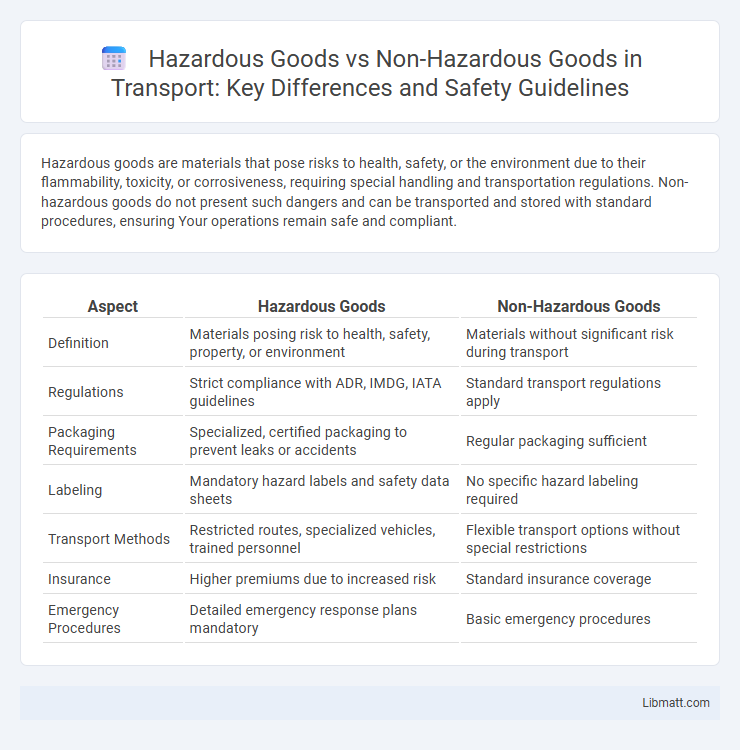Hazardous goods are materials that pose risks to health, safety, or the environment due to their flammability, toxicity, or corrosiveness, requiring special handling and transportation regulations. Non-hazardous goods do not present such dangers and can be transported and stored with standard procedures, ensuring Your operations remain safe and compliant.
Table of Comparison
| Aspect | Hazardous Goods | Non-Hazardous Goods |
|---|---|---|
| Definition | Materials posing risk to health, safety, property, or environment | Materials without significant risk during transport |
| Regulations | Strict compliance with ADR, IMDG, IATA guidelines | Standard transport regulations apply |
| Packaging Requirements | Specialized, certified packaging to prevent leaks or accidents | Regular packaging sufficient |
| Labeling | Mandatory hazard labels and safety data sheets | No specific hazard labeling required |
| Transport Methods | Restricted routes, specialized vehicles, trained personnel | Flexible transport options without special restrictions |
| Insurance | Higher premiums due to increased risk | Standard insurance coverage |
| Emergency Procedures | Detailed emergency response plans mandatory | Basic emergency procedures |
Definition of Hazardous Goods
Hazardous goods are materials or substances that pose significant risks to health, safety, property, or the environment due to their chemical or physical properties. These goods include flammable liquids, toxic chemicals, corrosive substances, and explosive materials as classified by regulations such as the UN Model Regulations and OSHA standards. Non-hazardous goods, in contrast, do not present such risks and are generally safe to handle, store, and transport without special precautions.
Definition of Non-Hazardous Goods
Non-hazardous goods are items that pose no significant risk to health, safety, property, or the environment under normal transportation and handling conditions. These goods do not require special labeling, packaging, or regulatory compliance compared to hazardous goods, which include substances like flammable materials, toxic chemicals, and explosives. Understanding the definition of non-hazardous goods helps you streamline logistics by ensuring proper classification and adherence to relevant shipping regulations.
Key Differences Between Hazardous and Non-Hazardous Goods
Hazardous goods contain substances that pose risks to health, safety, property, or the environment, requiring strict regulations for packaging, labeling, and transportation under frameworks like the UN Model Regulations. Non-hazardous goods lack these risks and are subject to standard shipping procedures without the need for special handling or documentation. Understanding these distinctions ensures Your compliance with legal requirements and promotes safe logistics management.
Classification Systems for Hazardous Materials
Classification systems for hazardous materials, such as the UN Model Regulations and OSHA standards, categorize goods based on their physical, chemical, and health hazards to ensure safe handling and transport. Non-hazardous goods fall outside these strict regulations due to their minimal risk profiles. Understanding these classification systems helps you comply with legal requirements and protect health and safety during logistics operations.
Regulatory Requirements for Hazardous Goods
Regulatory requirements for hazardous goods include strict compliance with international standards such as the UN Recommendations on the Transport of Dangerous Goods and regional regulations like the ADR in Europe or the DOT regulations in the United States. Hazardous goods must be classified, packaged, labeled, and documented according to specific guidelines to ensure safe handling, transportation, and storage. Non-hazardous goods are subject to less stringent regulations, primarily focusing on general shipping safety and customs documentation.
Packaging and Labeling Standards
Hazardous goods require packaging that meets strict regulatory standards such as UN certification to ensure containment and prevent leaks or contamination during transit, while non-hazardous goods often use standard commercial packaging without such rigorous specifications. Labeling for hazardous materials must include specific hazard pictograms, UN numbers, handling instructions, and emergency response details in compliance with regulations like the Globally Harmonized System (GHS) and international transport codes (e.g., ADR, IATA). Non-hazardous goods labeling typically involves basic product information and barcodes without mandatory hazard communication elements.
Transportation and Storage Considerations
Transportation and storage of hazardous goods require strict adherence to regulations such as the IMDG Code or ADR to prevent accidents, including specialized packaging, labeling, and segregation from incompatible substances. Non-hazardous goods typically allow for more flexible handling and storage conditions without the need for rigorous safety measures. Ensuring your hazardous materials are correctly classified and documented is critical to maintaining safety and regulatory compliance during transit and storage.
Safety Procedures and Risk Management
Hazardous goods require stringent safety procedures including specialized packaging, clear labeling, and adherence to regulatory standards such as OSHA and DOT guidelines to prevent incidents during handling and transportation. Risk management for hazardous materials involves comprehensive training for personnel, emergency response planning, and continuous monitoring to mitigate exposure and environmental impact. In contrast, non-hazardous goods generally follow standard safety protocols with less regulatory complexity and lower risk levels, focusing primarily on damage prevention and basic occupational safety.
Environmental Impact: Hazardous vs Non-Hazardous Goods
Hazardous goods pose significant environmental risks due to their toxic, flammable, or corrosive properties, leading to soil contamination, water pollution, and air quality degradation if mishandled. Non-hazardous goods generally have minimal environmental impact during transportation and storage, presenting fewer challenges in waste management and spill response. You should prioritize proper labeling, handling, and disposal protocols to mitigate negative environmental effects associated with hazardous materials.
Compliance and Documentation Essentials
Compliance with hazardous goods requires strict adherence to regulations such as OSHA, DOT, and IMO, including accurate labeling, packaging, and Material Safety Data Sheets (MSDS). Non-hazardous goods demand fewer documentation requirements but still require proper invoices, packing lists, and certificates of origin to ensure smooth customs clearance and regulatory compliance. Failure to meet documentation standards for hazardous goods can lead to severe legal penalties, shipment delays, and safety risks.
hazardous goods vs non-hazardous goods Infographic

 libmatt.com
libmatt.com